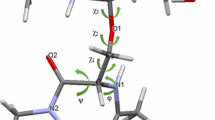Abstract
The three-dimensional structures of fourteen histo-blood groups carbohydrate antigens have been established through a combination of molecular mechanics and conformational searching methods. The conformational space available for each disaccharide, constituents of these determinants, has been throroughly characterized. The results have been organized in a data bank fashion. Larger relatives, i.e. 14 tri- and tetrasaccharides of histo-blood group antigens, have been modelled using a different method for exploring the complex potential energy surface. This approach is aimed at establishing all the possible families of conformations, along with the conformational pathways. Different conformational behaviours are exhibited by these oligosaccharides. Some of them, i.e. LeX and LeY tri and tetrasaccharides, are very rigid; 99% of their populations belong to the same conformational family. Others, like H type 1, H type 2 or H type 6 oligosaccharides, are essentially rigid, but a secondary conformational family, corresponding to 3–4% of the total population, can arise. Finally, the H types 3 and 4 trisaccharides, and the A type 1 and A type 2 tetrasaccharides are predicted to behave rather flexibly. The information gathered in the present investigation has been used to analyse the body of experimental evidence, either physical or biological, available for this series of carbohydrate antigens. Of special interest are the several different alignments that can be proposed for these molecules. They yield a realistic definition of the three-dimensional features of the epitopes thereby providing essential information about how carbohydrate antigens are recognized by proteins.
Similar content being viewed by others
References
King M-J (1994)Biochim Biophys Acta 1197:15–44.
Clausen H, Hakomori S (1989)Vox Sang 56:1–20.
Oriol R, Le Pendu J, Mollicone R (1986)Vox Sang 51:161–71.
Oriol R (1995) InBlood Cell Biochemistry Vol 6 (Cartron JP, Rouger P, eds) pp. 37–73. New York: Plenum Press
Oriol R, Cooper D, Davies JE, Keeling PWN (1984)Lab Invest 50:514–18.
Lasky LA (1992)Science 258:964–69.
Yuen, C-T, Bezouska K, O'Brien J, Stoll M, Lemoine R, Lubineau A, Kiso M, Hasegawa A, Bockovich NJ, Nicolaou KC, Feizi T (1993)J Biol Chem 269:1596–98.
Hakomori S (1989)Adv Cancer Res 52:257–331.
Lemieux RU, Bock K, Delbaere LTJ, Koto S, Rao VS (1980)Can J Chem 58:631–53.
Biswas M, Rao VSR (1980)Biopolymers 19:1555–65
Rao VSR, Biswas M (1985)Top Mol Struct Biol 8:185–218.
Yan Z-Y, Bush CA (1990)Biopolymers 29:799–811.
Cagas P, Bush CA (1992)Biopolymers 32:277–92.
Berg EL, Robinson MK, Mansson O, Butcher EC, Magnani JL (1991)J Biol Chem 266:14869–72.
Rutherford TJ, Spackman DG, Simpson PJ, Homans SW (1994)Glycobiology 4:59–68.
Kogelberg H, Rutherford TJ (1994)Glycobiology 4:49–57.
Toma L, Ciuffreda P, Colombo D, Ronchetti F, Lay L, Panza L (1994)Helv Chim Acta 77:668–78.
Imberty A, Bourne Y, Cambillau C, Rougé P, Pérez S (1993)Adv Biophys Chem 3:71–117.
Bourne Y, Rougé P, Cambillau C (1992)J Biol Chem 267:197–203.
Cooke RM, Hale RS, Lister SG, Shah G, Weir MP (1994)Biochemistry 33:1051–96.
Bundle DR, Baumann H, Brisson J-R, Gagné SM, Zdanov A, Cygler M (1994)Biochemistry 33:5183–92.
MM3(1992), QCPE, Creative Arts Building 181, Indiana University, Bloomington, IN 47405, USA.
Allinger NL, Yuh YH, Lii JH (1989)J Am Chem Soc 111:8551–66.
Pérez S, Imberty A, Carver JP (1994)Adv Comput Biol 1:146–202.
French AD, Dowd MK (1993)J Mol Struct (Theochem)286:183–201.
Koča J (1994)J Mol Struct (Theochem)308:13–24.
Koča J, Pérez S, Imberty A (1995)J Comp Chem 16:296–310.
Pérez S, Delage M-M (1991)Carbohydr Res 212:253–59.
IUPAC-IUB (1971) Commission on Biochemical Nomenclature.Arch Biochem Biophys 145:405–21.
Marchessault RH, Pérez S (1979)Biopolymers 18:2369–74.
Koča J (1993)J Mol Struct 291:255–69.
Imberty A, Pérez S (1994)Glycobiology 4:351–66.
SYBYL 6.04, Tripos Associates, 1699 S. Hanley Road, Suite 303, St Louis, MO 63144, USA.
Lemieux RU, Koto S, Voisin D (1979) InAnomeric Effect, Origin and Consequences ACS Symposium Series Vol 87 (Szarek A, Horton D, eds) pp. 17–29. Washington DC: American Chemical Society.
Delbaere LTJ, Vandonselaar M, Prasad L, Quail JW, Wilson KS, Dauter Z (1993)J Mol Biol 230:950–65.
Scheifer L, Senderowitz H, Aped P, Tartakowsky E, Fuchs B (1990)Carbohydr Res 206:21–39.
Brünger AT, Krukowski A, Erikson JW (1990)Acta Crystallogr A 47:585–93.
Rao BNN, Dua VK, Bush CA (1985)Biopolymers 24:2207–29.
Cagas P, Kaluarachchi K, Bush CA (1991)J Am Chem Soc 113:6815–22.
Ejchart A, Dabrowski J, von der Lieth C-W (1992)Magn Res Chem 30:S105–14.
Cagas P, Bush CA (1990)Biopolymers 30:1123–38.
Homans SW, Forster MJ (1992)Glycobiology 2:143–51.
Miller KE, Mukhopadhyay C, Cagas P, Bush CA (1992)Biochemistry 31:6703–9.
Yan Z-Y, Rao BNN, Bush CA (1987)J Am Chem Soc 109:7663–69.
Hagler AT, Lifson S, Dauber P (1979)J Am Chem Soc 101:5122–30.
Allinger NL, (1977)J Am Chem Soc 99:8127–34.
Bush CA, Yan Z-Y, Rao BNN (1986)J Am Chem Soc 108:6168–73.
Oriol R, Samuelsson BE, Messeter L (1990)J Immunogen 17:279–99.
Good AH, Yau O, Lamontagne LR, Oriol R (1992)Vox Sang 62:180–89.
Author information
Authors and Affiliations
Rights and permissions
About this article
Cite this article
Imberty, A., Mikros, E., Koca, J. et al. Computer simulation of histo-blood group oligosaccharides: energy maps of all constituting disaccharides and potential energy surfaces of 14 ABH and Lewis carbohydrate antigens. Glycoconjugate J 12, 331–349 (1995). https://doi.org/10.1007/BF00731336
Received:
Revised:
Issue Date:
DOI: https://doi.org/10.1007/BF00731336




